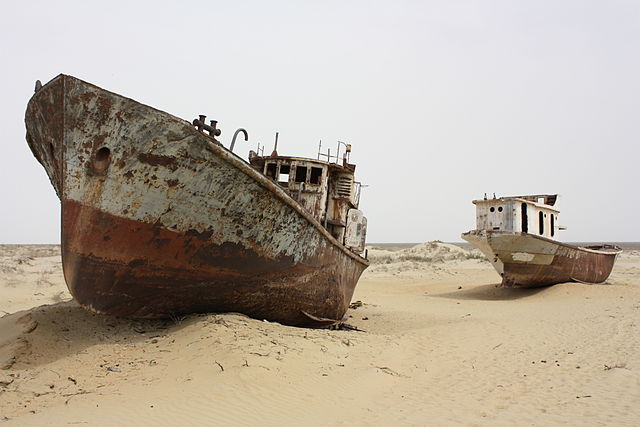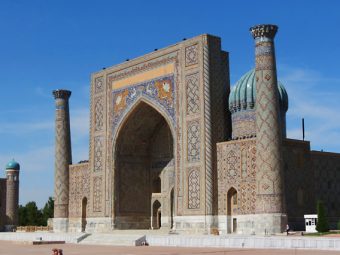As ghostly ships are left to rust in the Uzbek desert, there is little sign of the Aral Sea making a comeback.
Once a rich fishing port, Muynaq is now an abandoned relic left behind from one of the worst ecological disasters seen this side of the 1900s, and has become a morbidly curious stopping point for those driving across Central Asia.
The Shrinking Sea
Muynaq (also spelled in different ways) once sat on the shore of the Aral Sea, which once claimed the title of being the fourth largest lake in the world, and was proud fishing village hauling in a catch of 160 tons of fish a day.
The Aral Sea once stretched out over 68,000 square kilometres back in the 1950s, but now it’s mostly disappeared, with Muynaq now stuck in the middle of the desert in the heart of Central Asia, more than 150 kilometers from water.
Unlike archaeological evidence or geological formations showing the presence of water in now parched salt-flats, Muynaq’s ships now rust in the sun in an eerie nautical graveyard in an Uzbek desert.
Sucked Dry by the Soviet Union
The Aral Sea has shrunk to 10% of its original size, but how? Soviet engineers in the 1940s wanted to turn the desert into a cotton-growing paradise, and diverted the two rivers that ran into the lake for irrigation purposes.
The entire water supply to the lake was gone, with 20 to 60 cubic kilometers being used for irrigation rather than topping up the lake.
The lake soon vanished, where only a small segment was saved up in the northern shores of the Aral Sea. Environmentalists call it the biggest ecological disaster of the 20th century.
A Chance for Recovery
If you cross the border up into Aralsk, Kazakhstan, it’s not all grim news where the Aral Sea is concerned, and a glimmer of hope is washing back into the shores along the northern coastline.
Conservation might not make it high up the list of priorities in Uzbekistan, but in Kazakhstan, the remaining part of the Aral Sea will be getting a watery injection of life into it from the Syr Darya river, which should help the salt water lake recover slightly.
Contained by a large dam, the remaining water in the area of Aralsk shows hope, since the water levels rose from 30m to 45m, and could continue further should the plans for the river get set in motion.
People are moving back to the region, and Aralsk as a town is flourishing again.
While most of the fish died out in the extremely salty and contaminated water, only fit for brine shrimp, now the water levels have started to rise again, so has the number of fish.
Fishermen take to the sea again and even the rusty harbors are seeing the water creep closer and closer each day, and perhaps the sea might even reach the port town once again in a couple of decades.
You’d think scientists would be more about doom and gloom about the fate of the Aral Sea, but recent studies have shown that it’s not the first time the large lake has dried up and made a comeback.
Geologists have discovered that the Aral Sea has changed shape, form and depth a number of times, and has even grown back at some point.
The bad news is that unless drastic action is taken in the south, it’s unlikely the Uzbek part of the sea will be restored. Redirecting the water currently irrigating the crops back into the Aral Sea could restore it to its future glory, but that too will have its price in saving farms.
But there is still hope left for the Aral Sea, and it’s creeping closer to the shores of Aralsk each day.





Leave a Reply